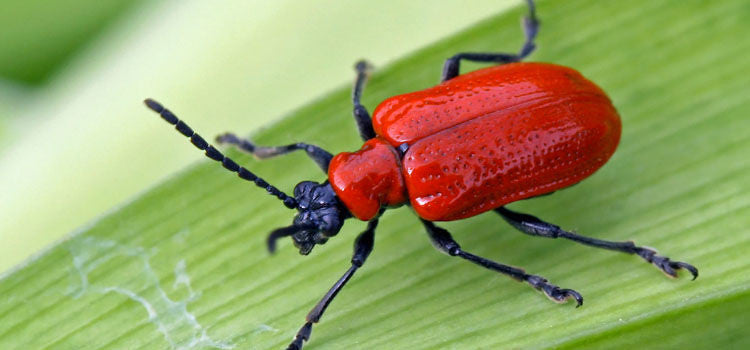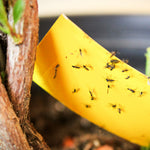Here is a re-post from our email newsletter, May 12, 2016, which many gardeners have asked us to make available on our blog.
Two of the most common questions we have been getting over the last week are:
1) What to do about Lily Beetles
2) When will the beneficial nematodes be available?
So, we thought it a good idea to share a little general info on these two topics. Let's start with the hard one... Lily Beetles. These rather attractive, bright-red pests have had a major impact on gardens around Manitoba over the last 5 years or so. Almost anyone who grows lilies in our area has by now had a moment of reckoning with this problem (lily plants are quickly devastated once afflicted), and unfortunately the solution is not simple. The beetle itself is a European import and has no natural predators in North America, allowing it to run rampant. Furthermore it winters easily in cold climates, which means even our harshest season is no challenge for the pest. Lastly, there are no pesticides - organic or otherwise - registered for use against the lily beetle in North America.
Right around now adult lily beetles are emerging from leaf debris around the garden and getting ready to ascend plants to lay eggs on leaf undersides (they are thankfully mostly dedicated to lilies and do not often implicate other types of perennials). The first step in spring control is finding adult beetles and hand-picking them. It is extremely important to reduce the adult population now, so as to limit the number of eggs laid. Aside from hand picking, the application of diatomaceous earth (available at Sage as a natural ant killer; this product is completely non-toxic and works by scuffing the beetles, causing them to dry out) can be used to control the beetles when sprinkled around the base of lily plants in the path of emerging adult beetles.
Even with diligent hand picking, some adult beetles will successfully lay egg - which unfortunately means dealing with the grossest stage in the beetle's life cycle: the larval stage. To take a quick step backwards, there is some opportunity in looking for the yellow eggs on the leaf undersides, and squishing these before they hatch. Not fun but effective. And no where near as disgusting as handling the larvae, which coat themselves in their own feces for protection. Gloves are recommended when picking these off. Some gardeners have found success in applying Safer's End-All to the larvae and eggs, since they are more vulnerable to the contact pyrethrum spray when compared to the hard-shelled adults. Larvae eventually fall off the plants, blending in with the surrounding soil and finally emerging as the next generation of adults.
To recap, this is a hard problem with no easy answers. Aside from diligent observation and hand-picking at various stages in the beetle's development, the tool-kit for control includes diatomaceous earth and possibly the non-labelled use of insecticides such as Safer's End-All. Come fall it is critical that all leaf debris be picked up from around garden-grown lilies, as this is where the beetles over winter. It is also vital to get neighbours on board for control, as all of your hard work is quickly undermined if near by gardeners have uncontrolled lily beetles. Realistically many gardeners are taking a break from lilies (so sad!) until more effective options become available; the most hopeful of these future options include resistant varieties of lilies as well as a particular imported beneficial insect that controls them.
_____________________
So what about nematodes for flea beetle control (and cut worms too!)?
Nematodes are very tiny, in fact microscopic, living organisms that are naturally occurring in soils. Some nematodes are harmful to plants, while others are beneficial and help control a variety of pests. Gardeners are able to apply beneficial nematodes to the soil in spring to help control flea beetles and cutworms (actually many other pests as well). Nematodes are applied by watering them into the garden when soil temperatures reach around 10 degrees Celsius (late May). Some faith is required when using nematodes, as they come on a sponge containing 10,000,000 of them yet you will never see one! The sponge is placed in a watering can or dial sprayer, and each covers 500 square feet of garden. The nematodes kill off the over wintered pest larvae, which allows other control measures such as row covers to work much more effectively.
Beneficial nematodes are available right now at Sage. One unit of 10,000,000 costs $36.95, and covers 500 square feet. Nematodes are perishable but the sponges can be cut into pieces and applied over time; unused product can be stored for about 6 weeks in the refrigerator. The nematodes available at Sage are all native species and will not disrupt local soil ecology.







